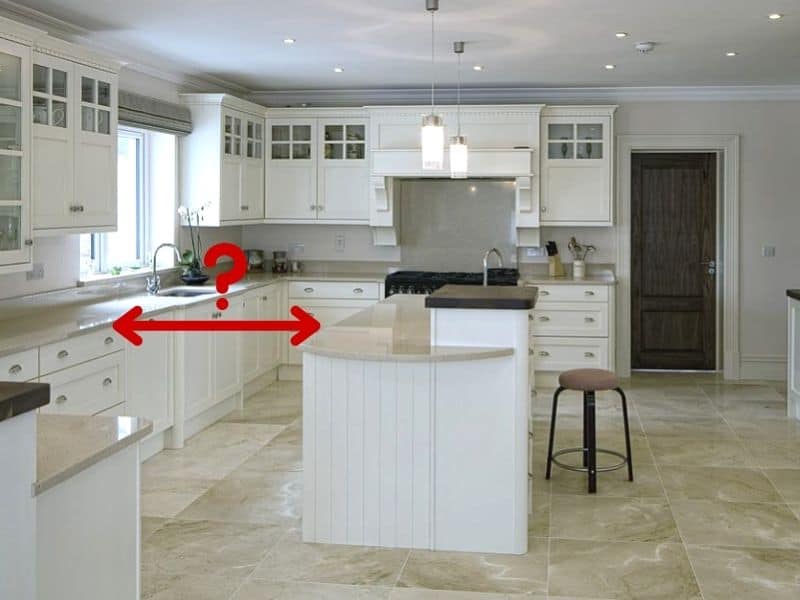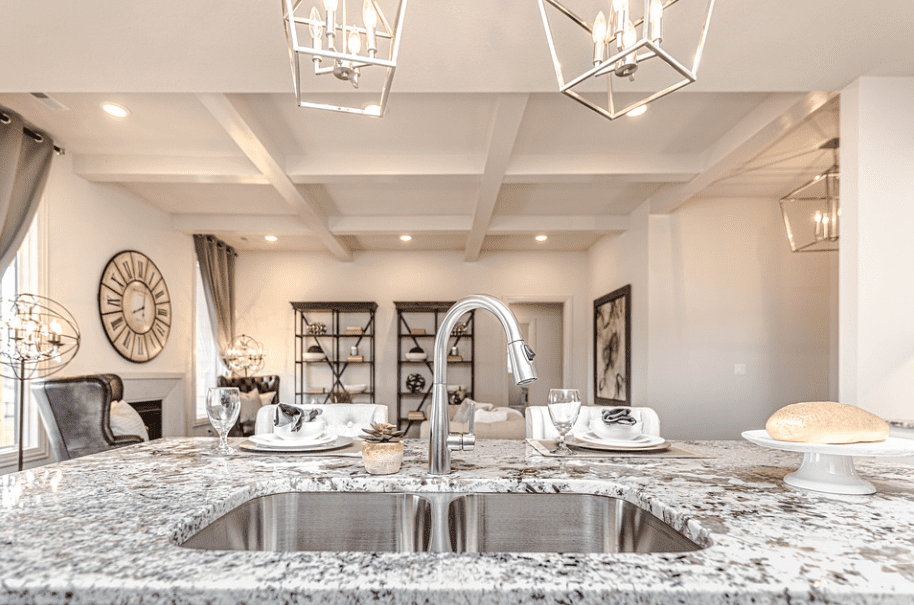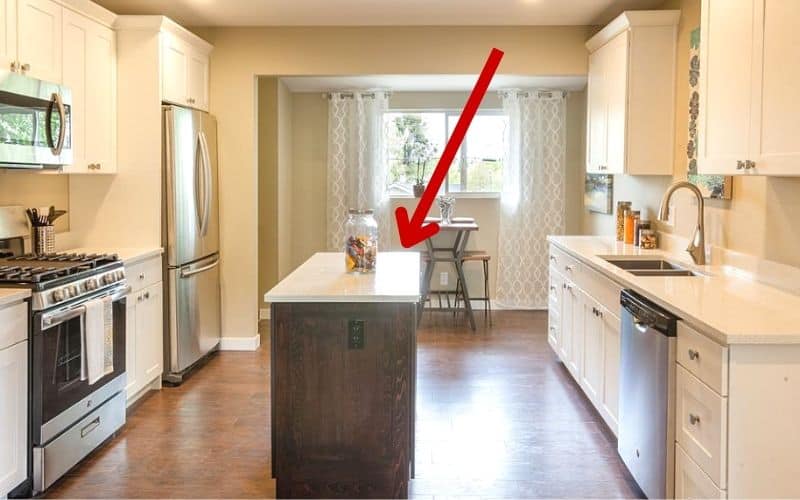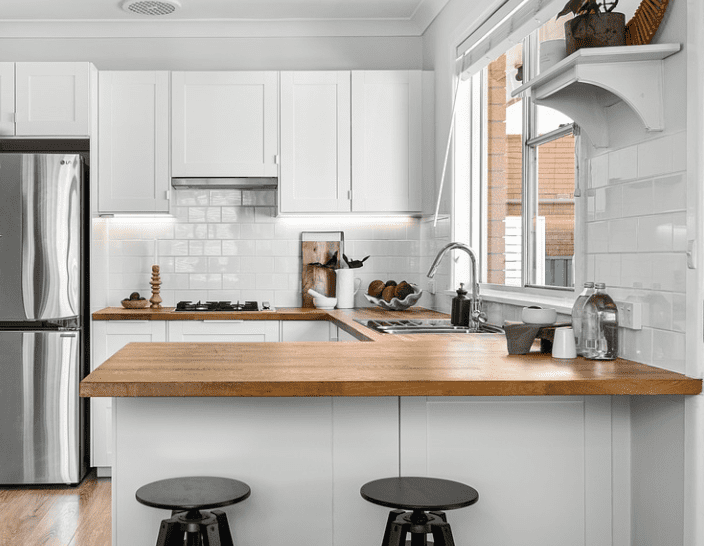Kitchen islands are one of the best features you can add to a kitchen.
As islands provide numerous benefits, including increased counter space, extra seating, and additional storage.
If you’re thinking about adding an island to your kitchen, however, there are a few things you need to take into consideration, most importantly of which is whether or not you have enough room to add a kitchen island, in the first place.
As not all kitchens are large enough or wide enough to accommodate a center island.
So how big should a kitchen be to have an island?
While the needed kitchen size can vary based on the kitchen configuration and the size of the island.
In general, in order to accommodate a minimal 3-foot by 5-foot kitchen island, the kitchen needs to be at least 14 feet wide by 16 feet long, give or take a few inches, to accommodate for standard counter depths and minimum clearances.
If you’re looking for a more detailed answer though, make sure to keep reading.
As we detail how much space you need between the kitchen counter and an island, how much overhang you need for seating, as well as what you can do if you don’t have enough space for a kitchen island below.
How Much Space Is Needed Between a Kitchen Counter and an Island?

The ideal amount of space between a kitchen counter and an island should be between 40 and 63 inches.
As this will provide enough space for two people to comfortably pass each other and to open all kitchen drawers and cabinets, while at the same time not being too much space.
Because while you might assume that more space is always better when it comes to the spacing between a kitchen counter and an island, this is only true up to a certain limit.
As adding more than 63 inches of space between the kitchen counter and the island will typically require you to take an extra step to transition from the counter to the island, which will make the kitchen less functional and more awkward to work in.
How Wide is a Standard Kitchen Island?
It can be challenging to pin down a standard kitchen island width, due to the wide range of kitchen sizes and configurations, as both of these factors will have a direct impact on the overall size of the island.
For example, a smaller kitchen measuring 14 feet wide by 16 feet long, might only be able to accommodate a 3-foot wide by 5-foot long island.
While a larger kitchen measuring 18 feet wide by 22 feet long, might be able to accommodate a 7-foot wide by 9-foot long island.
However, in general, most kitchen islands will usually have a width of between 3 and 6 feet and a length of between 5 and 10 feet, depending on the size and the configuration of the kitchen.
How Much Overhang Should a Kitchen Island Have for Seating?
One of the most desirable features of a kitchen island is an incorporated seating area.
Which can either be at countertop height (36″), or at a higher level than the rest of the island, which is typically referred to as a breakfast bar or a bar top.
As this additional seating provides a ton of extra usability and functionality to the kitchen and provides a great place to have a quick meal or just hang out.
A common question about these kitchen island seating areas though, is how much of an overhang do you need to provide a comfortable place to sit?
A kitchen island should ideally have between 12 and 15 inches of overhang in order to provide plenty of room for legs and to maximize seating comfort.
However, this is not always possible in smaller kitchens or in tighter spaces, so in these instances, you should strive to have at least 8 inches of overhang.
As any less overhang will require sitting partially sideways or farther back from the island.
It should also be pointed out that the amount of overhang on a kitchen island will affect the type and size of hightop seating the island can accommodate as well.
For example, simple bar stools with no back will take up much less space and require much less overhang compared to elaborate high-top chairs with armrests and backrests.
In addition, it’s also important to keep in mind that anything over 12 inches of overhang, will typically require some type of bracing, depending on the countertop material.
How to Design and Plan Out a Kitchen Island
Step 1: Decide on the design and what features you want to be incorporated into the island, such as a sink, a range, a microwave, seating, a breakfast bar, and or cabinets.
Step 2: Determine how much space you need for walkways around the island by opening up cabinet doors and drawers. (Should Ideally Be at Least 40 Inches)
Step 3: Open appliance doors on refrigerators, ovens, and dishwashers and simulate their use in order to see how much space you need to comfortably use the appliance.
Step 4: If you plan to have seating at your island, make sure to allow for extra space behind the seating, as you will need extra room to walk past the seating and to use it comfortably. (Should Ideally Have Around 5 Feet Behind Island Seating)
Step 5: Once you’ve determined the ideal size of the island, measure, and mark where the island will go. By placing blue painter’s tape on the floor to get a sense of how it will look and work in the space
Step 6: Don’t forget to think about lighting when planning your island to determine if and where any lighting might be placed above the island, such as recessed lighting or pendant lights.
Can You Put an Island in a 10×10 or 10×12 Kitchen?
While you should ideally have a kitchen that’s 14 feet by 16 feet in order to accommodate a minimal 3-foot by 5-foot kitchen island.
These minimum size requirements assume that the kitchen in question is either a galley kitchen or that the kitchen island will be flanked by cabinets on either side.
As these scenarios have to leave enough room to not only account for two walkways on either side of the island but also 25 and a half inches of space on either side of the island for opposing kitchen cabinets and countertops.
However, if you have a “one-wall kitchen” that only has kitchen cabinets and appliances on one wall, then you can get away with less than 14 feet of kitchen width.
As you only have to leave enough space for one wall of kitchen cabinets as opposed to two, saving you 25 and a half inches of space or just over two feet.
Allowing you to get away with 12 feet of kitchen width as opposed to 14 feet, while still accommodating a 3-foot wide island.
Is 36 Inches Enough Space Between Counter and Island?
Ideally, you should have at least 40 inches of space between the kitchen counter and the island.
As this will provide not only enough space to open all appliances and cabinets but also enough room for two people to comfortably pass each other.
However, 40 inches of space between the counter and the island is not always possible, especially in smaller kitchens.
And in these instances, it is possible to go with less than 40 inches of space between the counter and the island.
If you do choose to go with less than 40 inches of walkway between the counter and the island though, it’s important to keep in mind that for every inch you lose you’re giving up a bit of comfort.
So you should try and stay as close to 40 inches as possible.
Should a Kitchen Island Be the Same Height as the Counter?
In most cases, the kitchen island should be the same height as the counter, which is typically 36 inches tall.
However, some kitchen islands feature breakfast bars or bar tops, which are typically slightly higher than standard countertop height, often being somewhere between 36 and 42 inches high.
Even in these instances though, the majority of the kitchen island is still usually standard countertop height, with only the breakfast bar or bar top section being slightly higher.
How Big Should an Island With a Sink Be?

The ideal minimum size of a kitchen island should be at least 3 feet by 5 feet to provide enough usability and counter space to the island to make it worthwhile.
However, this minimum size is not big enough to accommodate a kitchen sink or even a smaller bar sink.
So how big should a kitchen island be to accommodate a sink?
A standard double bowl kitchen sink is usually either 33 or 36 inches wide by 22 inches deep, while a single bowl or bar sink is typically 16 to 24 inches wide by 16 to 22 inches deep.
Because of this, an island with a sink should ideally be at least 5 feet by 7 feet, depending on the size of the sink, in order to maintain the ideal minimum amount of counter space on the island.
How Many Chairs Fit on a 6 Foot Island?
Kitchen island chairs should have between 20 and 24 inches of space per chair to provide an adequate amount of space for each chair.
Because of this, you should ideally not have more than 3 chairs or stools on a six-foot island.
How Long Should a Kitchen Island Be For 3 Stools?
Considering that each bar stool should ideally be provided a minimum of 20 inches of space per stool, a kitchen island would need to be 60 inches or 5 feet long at a minimum to accommodate 3 stools.
However, a 72-inch or 6-foot long kitchen island, would provide even more space for each stool and give everyone a little more breathing room.
What Can You Do If You Don’t Have Room for a Kitchen Island?
A kitchen island is one of the best upgrades you can make to a kitchen, as it provides increased counter space, extra seating, and additional storage.
Unfortunately, though, not every kitchen is going to have the needed space to accommodate an island.
Luckily though there is a great alternative to the kitchen island that offers the same benefits and features but takes up much less space, which is the kitchen peninsula.
As the kitchen peninsula provides increased counter space, extra seating, and additional storage while still being able to fit into smaller kitchens and tighter spaces.
Due to the fact that a peninsula does not need clearance on its fourth side, like an island, which allows the peninsula to fit in much smaller kitchens and tighter spaces.
Additional Resources
Recent Posts
Your bedroom is more than just a place to sleep; it's a personal sanctuary where you can unwind, relax, and recharge after a long day. Whether working with a small bedroom or a spacious suite,...
Are you ready to breathe new life into your living room? If so, look no further than modern living room colors, as they can transform your space from drab to fab. As the heart of the home, the...


